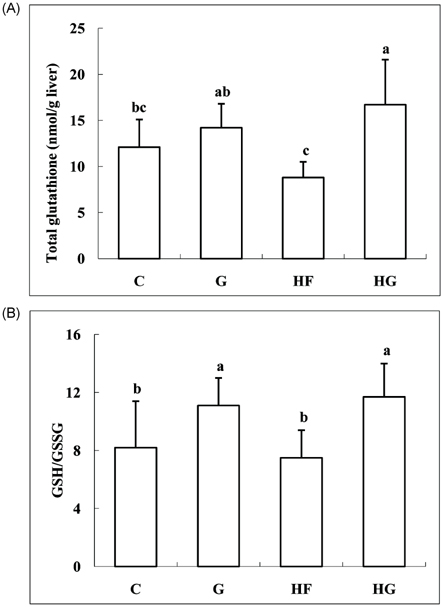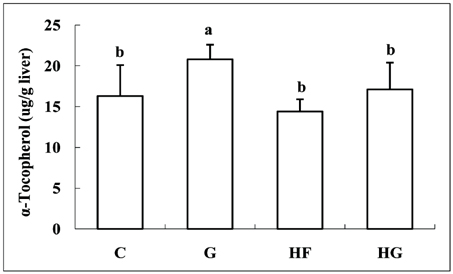Nutr Res Pract.
2012 Feb;6(1):3-8.
Suppression of oxidative stress by grape seed supplementation in rats
- Affiliations
-
- 1Department of Food and Nutrition, Yeungnam University, 280 Daehak-ro, Gyeongsan, Gyeongbuk 712-749, Korea. Jsseo@ynu.ac.kr
Abstract
- Polyphenol-rich grape seeds have a beneficial effect on human health. The present study was performed to investigate the effects of grape seeds on antioxidant activities in rats. Male Sprague-Dawley rats were randomly divided into a control diet group (C), a high-fat diet group (HF), a 5% grape seed-supplemented control diet group (G), and a 5% grape seed-supplemented high-fat diet group (HG). Dietary supplementation with grape seeds reduced serum concentrations of lipid peroxides compared with those in the C and HF groups. The hepatic level of lipid peroxides decreased significantly in the grape seed groups compared with that in the C and HF groups. Superoxide dismutase activity in the G group increased significantly compared with that in the C group. Catalase activity tended to be higher by feeding grape seeds. The grape seed diet increased glutathione peroxidase activity in the C group. Glutathione-S-transferase activity increased significantly in the G group compared with that in the C group. Hepatic content of total glutathione increased significantly in the HG group but decreased significantly in the HF group. The ratio of reduced glutathione and oxidized glutathione increased by feeding the grape seed diet. Total vitamin A concentration was significantly higher in HG group than in other groups. Liver tocopherol content of the G and HG groups was significantly higher than that of the control groups. These results suggest that dietary supplementation with grape seeds is beneficial for suppressing lipid peroxidation in high fat-fed rats.
Keyword
MeSH Terms
-
Animals
Catalase
Diet
Diet, High-Fat
Dietary Supplements
Glutathione
Glutathione Disulfide
Glutathione Peroxidase
Humans
Lipid Peroxidation
Lipid Peroxides
Liver
Male
Oxidative Stress
Rats
Rats, Sprague-Dawley
Seeds
Superoxide Dismutase
Tocopherols
Vitamin A
Vitis
Catalase
Glutathione
Glutathione Disulfide
Glutathione Peroxidase
Lipid Peroxides
Superoxide Dismutase
Tocopherols
Vitamin A
Figure
Reference
-
1. Bray GA, Paeratakul S, Popkin BM. Dietary fat and obesity: a review of animal, clinical and epidemiological studies. Physiol Behav. 2004. 83:549–555.
Article2. Ozata M, Mergen M, Oktenli C, Aydin A, Sanisoglu SY, Bolu E, Yilmaz MI, Sayal A, Isimer A, Ozdemir IC. Increased oxidative stress and hypozincemia in male obesity. Clin Biochem. 2002. 35:627–631.
Article3. Slattery ML, Curtin KP, Edwards SL, Schaffer DM. Plant foods, fiber, and rectal cancer. Am J Clin Nutr. 2004. 79:274–281.
Article4. Smith-Warner SA, Spiegelman D, Yaun SS, Albanes D, Beeson WL, van den Brandt PA, Feskanich D, Folsom AR, Fraser GE, Freudenheim JL, Giovannucci E, Goldbohm RA, Graham S, Kushi LH, Miller AB, Pietinen P, Rohan TE, Speizer FE, Willett WC, Hunter DJ. Fruits, vegetables and lung cancer: a pooled analysis of cohort studies. Int J Cancer. 2003. 107:1001–1011.
Article5. Cui J, Juhasz B, Tosaki A, Maulik N, Das DK. Cardioprotection with grapes. J Cardiovasc Pharmacol. 2002. 40:762–769.
Article6. Leifert WR, Abeywardena MY. Cardioprotective actions of grape polyphenols. Nutr Res. 2008. 28:729–737.
Article7. Torres JL, Varela B, García MT, Carilla J, Matito C, Centelles JJ, Cascante M, Sort X, Bobet R. Valorization of grape (Vitis vinifera) byproducts. Antioxidant and biological properties of polyphenolic fractions differing in procyanidin composition and flavonol content. J Agric Food Chem. 2002. 50:7548–7555.
Article8. Shi J, Yu J, Pohorly JE, Kakuda Y. Polyphenolics in grape seeds-biochemistry and functionality. J Med Food. 2003. 6:291–299.
Article9. Nandakumar V, Singh T, Katiyar SK. Multi-targeted prevention and therapy of cancer by proanthocyanidins. Cancer Lett. 2008. 269:378–387.
Article10. Mittal A, Elmets CA, Katiyar SK. Dietary feeding of proanthocyanidins from grape seeds prevents photocarcinogenesis in SKH-1 hairless mice: relationship to decreased fat and lipid peroxidation. Carcinogenesis. 2003. 24:1379–1388.
Article11. Beveridge TH, Girard B, Kopp T, Drover JC. Yield and composition of grape seed oils extracted by supercritical carbon dioxide and petroleum ether: varietal effects. J Agric Food Chem. 2005. 53:1799–1804.
Article12. Ahn HS, Jeon TI, Lee JY, Hwang SG, Lim Y, Park DK. Antioxidative activity of persimmon and grape seed extract: in vitro and in vivo. Nutr Res. 2002. 22:1265–1273.
Article13. Spranger I, Sun B, Mateus AM, de Freitas V, Ricardo-da-Silva JM. Chemical characterization and antioxidant activities of oligomeric and polymeric procyanidin fractions from grape seeds. Food Chem. 2008. 108:519–532.
Article14. Sato M, Maulik G, Ray PS, Bagchi D, Das DK. Cardioprotective effects of grape seed proanthocyanidin against ischemic reperfusion injury. J Mol Cell Cardiol. 1999. 31:1289–1297.
Article15. Sato M, Bagchi D, Tosaki A, Das DK. Grape seed proanthocyanidin reduces cardiomyocyte apoptosis by inhibiting ischemia/reperfusion-induced activation of JNK-1 and C-JUN. Free Radic Biol Med. 2001. 31:729–737.
Article16. Hogeboom GH. [3] Fractionation of cell components of animal tissues. Methods Enzymol. 1955. 1:16–19.
Article17. Yagi K. A simple fluorometric assay for lipoperoxide in blood plasma. Biochem Med. 1976. 15:212–216.
Article18. Ohkawa H, Ohishi N, Yagi K. Assay for lipid peroxides in animal tissues by thiobarbituric acid reaction. Anal Biochem. 1979. 95:351–358.
Article19. Aebi H. Bergmeyer HU, editor. Catalase. Methods of Enzymatic Analysis. 1974. Vol. 11. New York: Academic Press;673–684.
Article20. Marklund S, Marklund G. Involvement of the superoxide anion radical in the autoxidation of pyrogallol and a convenient assay for superoxide dismutase. Eur J Biochem. 1974. 47:469–474.
Article21. Paglia DE, Valentine WN. Studies on the quantitative and qualitative characterization of erythrocyte glutathione peroxidase. J Lab Clin Med. 1967. 70:158–169.22. Habig WH, Pabst MJ, Jakoby WB. Glutathione S-transferases. The first enzymatic step in mercapturic acid formation. J Biol Chem. 1974. 249:7130–7139.23. Anderson ME. Determination of glutathione and glutathione disulfide in biological samples. Methods Enzymol. 1985. 113:548–555.24. Furr HC, Amédée-Manesme O, Olson JA. Gradient reversed-phase high-performance liquid chromatographic separation of naturally occurring retinoids. J Chromatogr. 1984. 309:299–307.
Article25. Scandalios JG. Oxidative stress responses--what have genome-scale studies taught us? Genome Biol. 2002. 3:REVIEWS1019.26. Milagro FI, Campión J, Martínez JA. Weight gain induced by high-fat feeding involves increased liver oxidative stress. Obesity (Silver Spring). 2006. 14:1118–1123.
Article27. Hirao K, Maruyama T, Ohno Y, Hirose H, Shimada A, Takei I, Murata M, Morii T, Eguchi T, Hayashi M, Saruta T, Itoh H. Association of increased reactive oxygen species production with abdominal obesity in type 2 diabetes. Obes Res Clin Pract. 2010. 4:e83–e90.
Article28. Folmer V, Soares JC, Gabriel D, Rocha JB. A high fat diet inhibits delta-aminolevulinate dehydratase and increases lipid peroxidation in mice (Mus musculus). J Nutr. 2003. 133:2165–2170.
Article29. Lee SJ, Choi SK, Seo JS. Grape skin improves antioxidant capacity in rats fed a high fat diet. Nutr Res Pract. 2009. 3:279–285.
Article30. Niki E. Lipid peroxidation products as oxidative stress biomarkers. Biofactors. 2008. 34:171–180.
Article31. Choi CS, Chung HK, Choi MK, Kang MH. Effects of grape pomace on the antioxidant defense system in diet-induced hypercholesterolemic rabbits. Nutr Res Pract. 2010. 4:114–120.
Article32. Clementi E, Brown GC, Feelisch M, Moncada S. Persistent inhibition of cell respiration by nitric oxide: crucial role of S-nitrosylation of mitochondrial complex I and protective action of glutathione. Proc Natl Acad Sci U S A. 1998. 95:7631–7636.
Article33. Sen CK. Cellular thiols and redox-regulated signal transduction. Curr Top Cell Regul. 2000. 36:1–30.
Article34. Sehirli O, Ozel Y, Dulundu E, Topaloglu U, Ercan F, Sener G. Grape seed extract treatment reduces hepatic ischemia-reperfusion injury in rats. Phytother Res. 2008. 22:43–48.
Article35. Alía M, Horcajo C, Bravo L, Goya L. Effect of grape antioxidant dietary fiber on the total antioxidant capacity and the activity of liver antioxidant enzymes in rats. Nutr Res. 2003. 23:1251–1267.
Article36. Bozan B, Tosun G, Özcan D. Study of polyphenol content in the seeds of red grape (Vitis vinifera L.) varieties cultivated in Turkey and their antiradical activity. Food Chem. 2008. 109:426–430.
Article37. Ramchandani AG, Chettiyar RS, Pakhale SS. Evaluation of antioxidant and anti-initiating activities of crude polyphenolic extracts from seedless and seeded Indian grapes. Food Chem. 2010. 119:298–305.
Article38. Quettier-Deleu C, Voiselle G, Fruchart JC, Duriez P, Teissier E, Bailleul F, Vasseur J, Trotin F. Hawthorn extracts inhibit LDL oxidation. Pharmazie. 2003. 58:577–581.39. Schreckinger ME, Wang J, Yousef G, Lila MA, de Mejia EG. Antioxidant capacity and in vitro inhibition of adipogenesis and inflammation by phenolic extracts of Vaccinium floribundum and Aristotelia chilensis. J Agric Food Chem. 2010. 58:8966–8976.
Article40. Zern TL, Fernandez ML. Cardioprotective effects of dietary polyphenols. J Nutr. 2005. 135:2291–2294.
Article41. Goñi I, Martìn N, Saura-Calixto F. In vitro digestibility and intestinal fermentation of grape seed and peel. Food Chem. 2005. 90:281–286.
Article42. Chandalia M, Garg A, Lutjohann D, von Bergmann K, Grundy SM, Brinkley LJ. Beneficial effects of high dietary fiber intake in patients with type 2 diabetes mellitus. N Engl J Med. 2000. 342:1392–1398.
Article43. Rodríguez-Cabezas ME, Gálvez J, Lorente MD, Concha A, Camuesco D, Azzouz S, Osuna A, Redondo L, Zarzuelo A. Dietary fiber down-regulates colonic tumor necrosis factor alpha and nitric oxide production in trinitrobenzenesulfonic acid-induced colitic rats. J Nutr. 2002. 132:3263–3271.44. Ciaccio M, Valenza M, Tesoriere L, Bongiorno A, Albiero R, Livrea MA. Vitamin A inhibits doxorubicin-induced membrane lipid peroxidation in rat tissues in vivo. Arch Biochem Biophys. 1993. 302:103–108.
Article45. van Dam B, van Hinsbergh VW, Stehouwer CD, Versteilen A, Dekker H, Buytenhek R, Princen HM, Schalkwijk CG. Vitamin E inhibits lipid peroxidation-induced adhesion molecule expression in endothelial cells and decreases soluble cell adhesion molecules in healthy subjects. Cardiovasc Res. 2003. 57:563–571.
Article46. Frank J, Budek A, Lundh T, Parker RS, Swanson JE, Lourenco CF, Gago B, Laranjinha J, Vessby B, Kamal-Eldin A. Dietary flavonoids with a catechol structure increase alpha-tocopherol in rats and protect the vitamin from oxidation in vitro. J Lipid Res. 2006. 47:2718–2725.
Article47. Wie M, Sung J, Choi Y, Kim Y, Jeong HS, Lee J. Tocopherols and tocotrienols in grape seeds from 14 cultivars grown in Korea. Eur J Lipid Sci Technol. 2009. 111:1255–1258.
Article48. Sies H, Stahl W. Vitamins E and C, beta-carotene, and other carotenoids as antioxidants. Am J Clin Nutr. 1995. 62:1315S–1321S.
Article
- Full Text Links
- Actions
-
Cited
- CITED
-
- Close
- Share
- Similar articles
-
- Effects of grape pomace on the antioxidant defense system in diet-induced hypercholesterolemic rabbits
- The Effect of Isoflavone and/or Grape Seed Oil Supplementation on Blood Lipid Profiles and Bone Strength in Ovariectomized Female Rats
- The Effects of Purple Grape Juice Supplementation on Blood Pressure, Plasma Lipid Profile and Free Radical Levels in Korean Smokers
- Cytoprotective Effect of Polyphenolic Compounds against Oxidative Stress in Cultured Retinal Pigment Epithelial Cells
- Grape skin improves antioxidant capacity in rats fed a high fat diet




